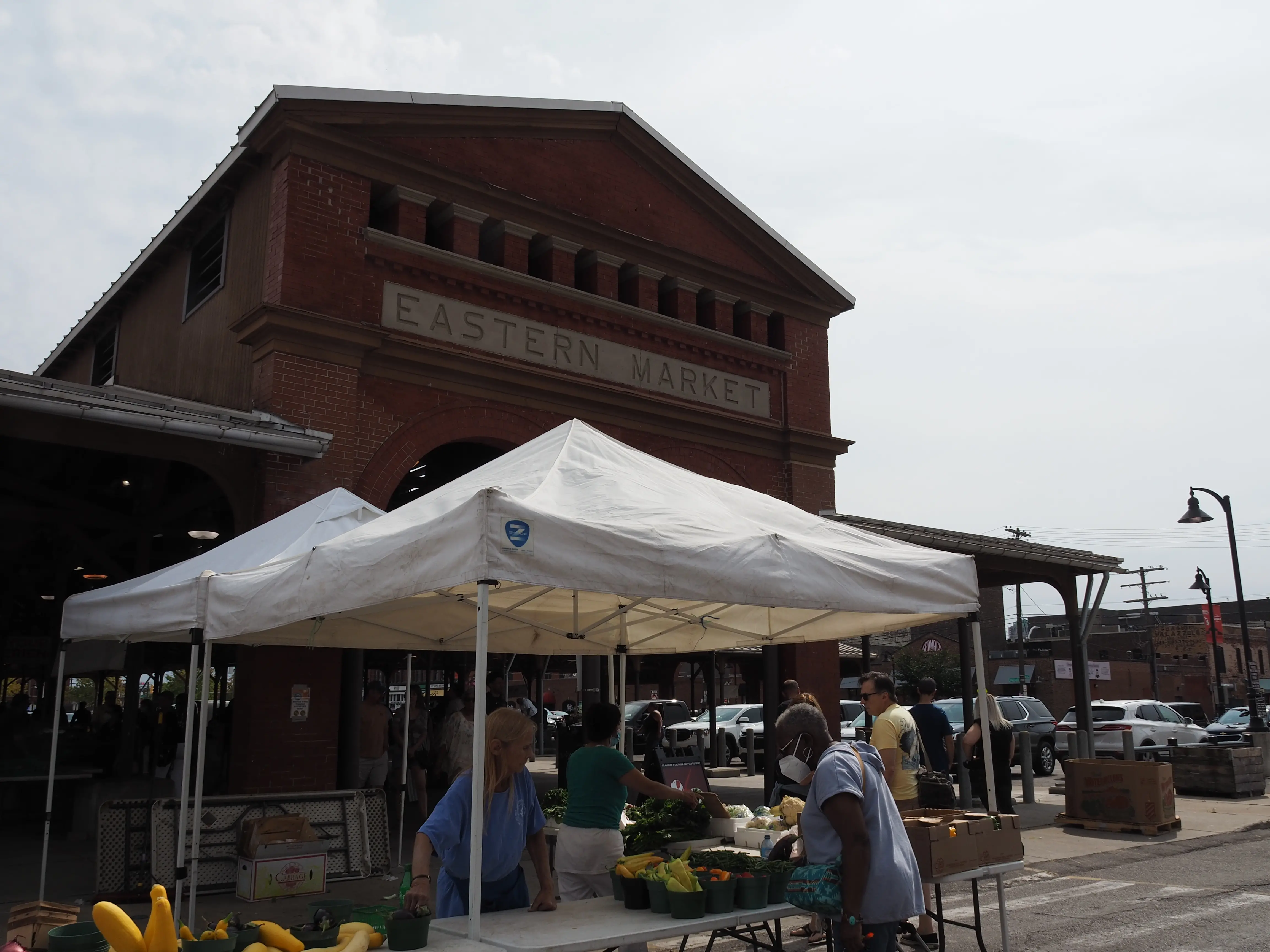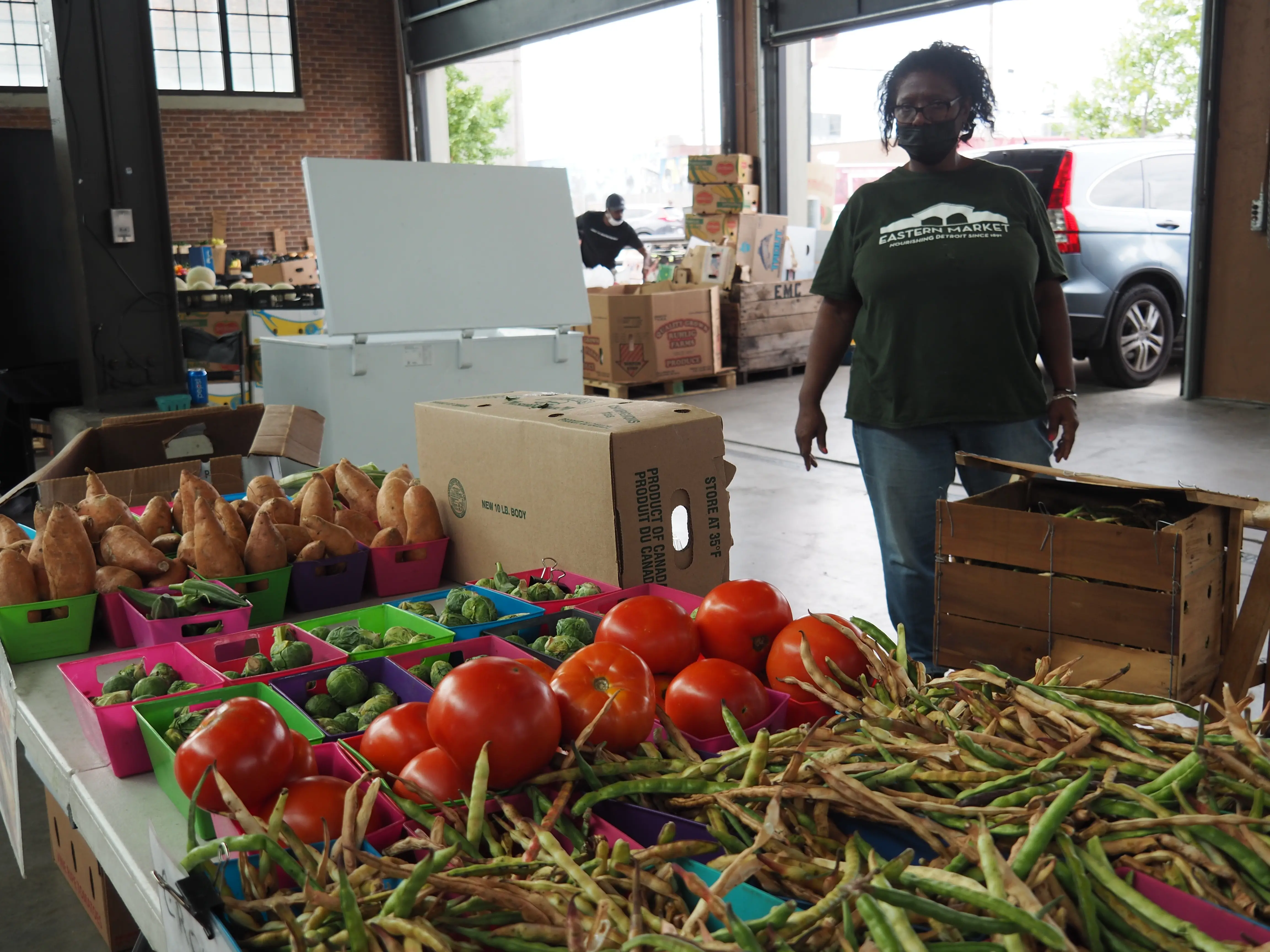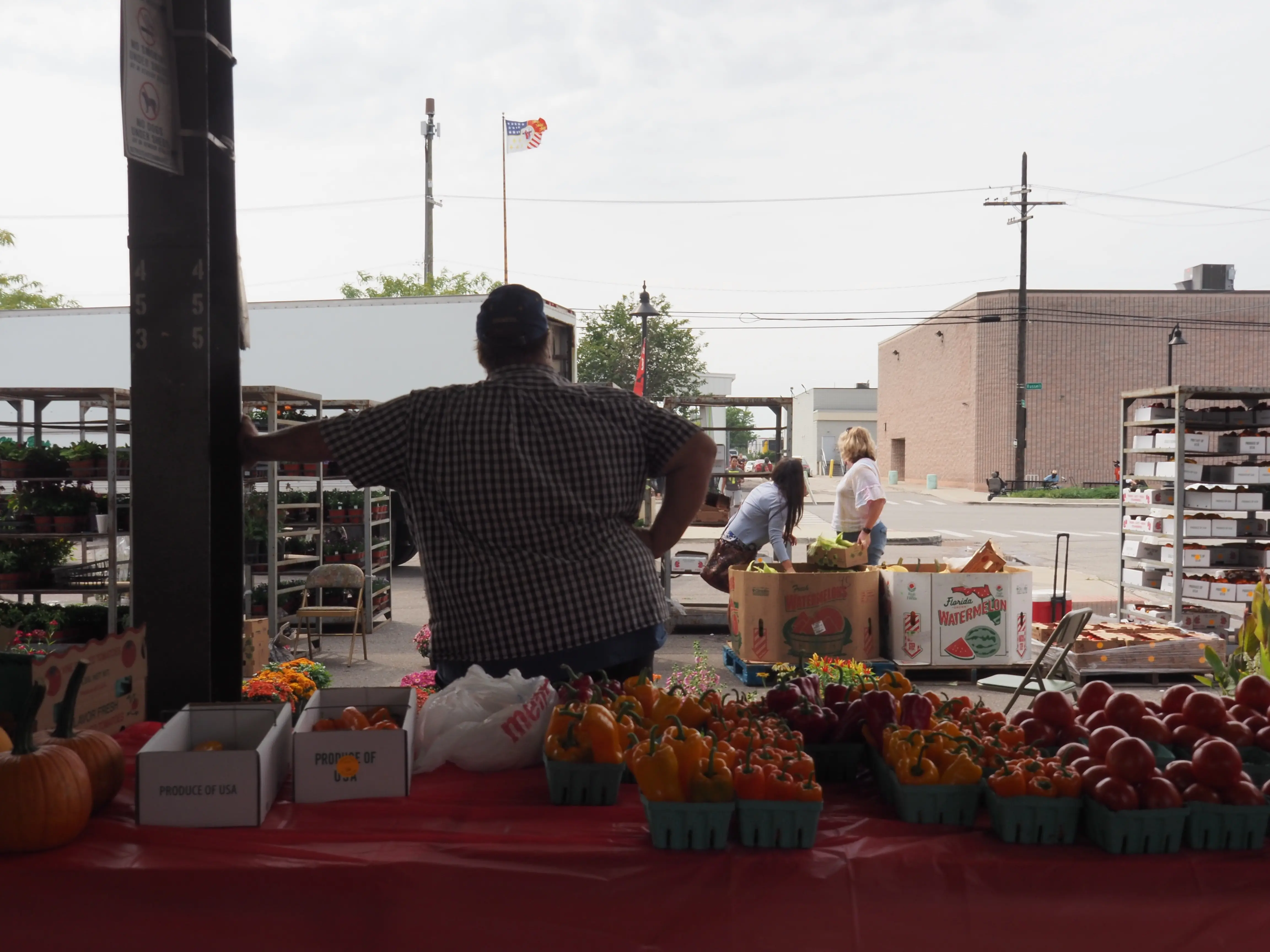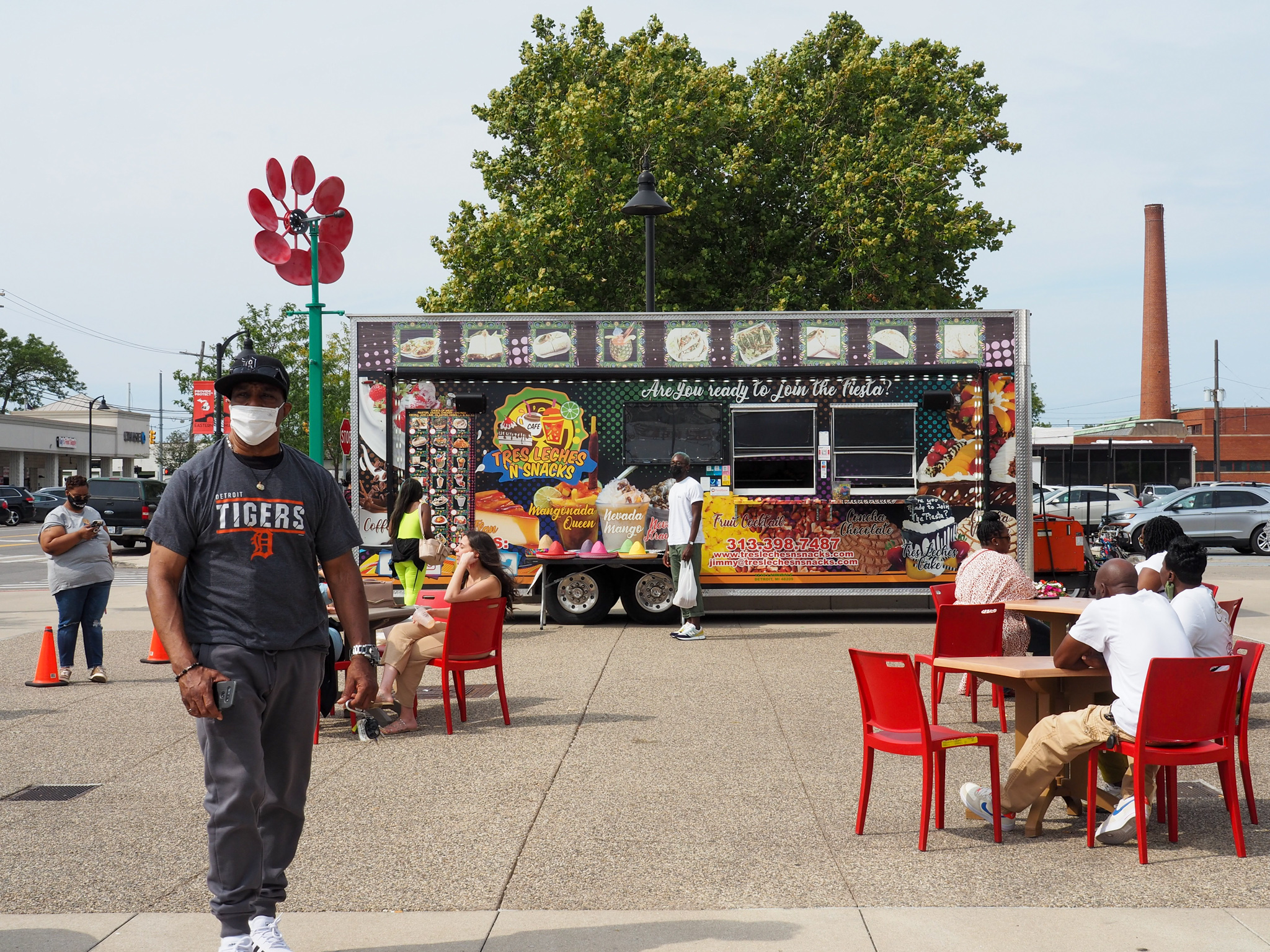Detroit is nicknamed "Motor City," and is known as the central hub for the U.S. auto industry. But the city is also the home to other phenomena. Motown. Lions and Pistons. A distinct pizza style. It is the birthplace of one of the oldest farmer’s markets in the country: Eastern Market.
I barreled into Detroit from the humid swamp of Charleston, South Carolina, where I am currently based, to begin my reporting project with the Pulitzer Center. My first stop upon arrival was the market. On that tepid autumn afternoon, thousands of Detroiters perused stands from local farmers and bought produce. I parked my car and filed among them.

Some of my favorite photos are from Eastern Market. The robust dome nearly busted at the seams with scores of food. Vibrant silhouettes of fruit, vegetables, and dairy lined up tables expanding hundreds of vendors.
I strolled through the market, speaking with vendors who have set up shop every Saturday for decades. The food was affordable and local. Live music bellowed at different corners of the market as families strolled from stand to stand.
As a reporter, I constantly find myself thinking of “the roots” when I am out in the field. I even conjure an image in my head of stories becoming branches or leaves, which are often connected to a tree full of articles.

It is a cliché, tacky visual. Yet whether it be day-to-day work beat reporting or writing longer-form pieces, I believe stories are rooted to one another through larger systemic issues.
As I jotted quotes and interviewed marketgoers, I wondered: How could this city where food supply was barren also be the same city where there is an Eastern Market, a city-wide staple where produce was ample? How can these two realities both live on the same tree?
I first wanted to report on food insecurity in Detroit back in March 2020 when I came to the city for the first time. I quickly felt a connection to Detroiters as I explored the landscape. Detroit has a vast footprint—nearly 143 square miles. That stood out to me. It is different from downtown Charleston, where the peninsula is about four to five square miles.
But for its vastness, it is also sparse. There is no Walmart, no Target within city limits. There is hardly a big-box grocer in any of its urban areas. It is a city built for two million people, though it has about 700,000 inhabitants.
That March, I heard stories from food rescue sources of people who lay in bed at night with their stomachs empty. I toured warehouses with ceilings-high stacks of packaged meals ready for donation.
I would think: “There needs to be reporting on this food desert.”
Yet amid my reporting, I have since learned my understanding of Detroit’s food desert was skewed.
I created a preconception of Detroit being without food supply and abandoned. I would drive through some streets and see abandoned homes. I pictured tumbleweeds.
Nevertheless, my understanding was inaccurate. There are food and people in Detroit. In fact, Michigan's population of nearly 10 million suggests that as much as two million tons of food waste are likely being disposed of within the state, according to the Michigan Recycling Coalition. What cultivates food insecurity in Detroit is not lack of supply.
I learned that in this motor city public transportation was not always accessible. Some people have to travel 12 miles to get to the nearest grocer.
If a Detroiter does not have a car or is wary of public transportation amid the COVID-19 pandemic, there are few affordable options to purchase produce. It also takes time to buy food and make meals—time people working on their feet for full days may not have.
There is also a gap in food education.
People perceive healthier foods to cost more, though there are plenty of healthy, inexpensive foods outside of Whole Foods. Further, it is more challenging for people raised on processed food to know how to cook.
I spent a great deal of time in Detroit thinking about ways to understand these gaps and how they residually impact food access.
I also thought about my own roots and relationship with food. I examined my own family tree.
My relationship with Detroit is fairly new, but I have known cities all my life. My family hails from the South Bronx. My parents were raised in low-income families, and so were their parents. My dad grew up knowing hunger all too well.
I am blessed in that I never knew hunger as he did. I grew up in the suburbs in an upper-middle class home. My parents worked long hours for their keep, and my siblings and I had access to food. My stomach was always full.
Pre-packaged, microwaveable meals were a staple for most of my dinners—both for their taste and affordability. We also ate fast food regularly each week. I failed to internalize how important nutritious foods were to my health.
I did not understand that when you eat better, you feel better. Sure, it’s taught in school, but I never really saw it in practice. I did not know how to cook—none of us did.
My struggles with eating have caught up with me as I have grown. When I started college, I knew I ought to eat healthy, but I lacked the know-how. I worked two, at times three, jobs each semester, and it was hard for me to buy groceries and keep within my budget.
I skipped meals often. Combined with the stress of assignments, sometimes I would go more than a day without a bite to eat.
I grew frustrated that my peers did not have the same problems with eating I had. There were healthy options at the dining hall, but the unhealthier options tasted better. I would look at the cafeteria with a myriad of meals and feel hopeless.
It has been a couple of months since I have left college, and that feeling of hopelessness has faded a lot. I have had more time to really find meals that are healthy, affordable, and enjoyable. I am also lucky to now be in better touch with my health.
Yet when I stood at Eastern Market, I had felt that same anxiety. I stood squarely facing the vendors and did not have a clue about where to begin.
Food deserts are not necessarily about landscape, but about barriers. And the barriers of today, perhaps, can also impact future generations' relationship with food.

I don’t quite know whether I will ever neatly understand food access in Detroit, as I once thought I had. It is a volatile issue, which cannot be examined in a vacuum. The preconceptions I had of the city, which propelled me to report on food insecurity, were inaccurate and lacked context. They were without roots.
Perhaps these assumptions motivate journalists to find stories and pitch them. But they fog the truth and are dangerous. Part of being a journalist is knowing when to identify one’s reporting is thin. I think empathy, and the invisible strings that connect us to our reporting, can help decipher such bias.
After a year of reporting, Detroit is a city still foreign to me in so many ways. I still have so much to listen and learn, especially in terms of reporting on food access. Though the community’s unique relationship with food hit close to home it healed a part of my own spirit that I'd never thought was wounded.











